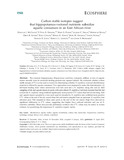| dc.contributor.author | McCauley, Douglas J. | |
| dc.contributor.author | Dawson, Todd E. | |
| dc.contributor.author | Power, Mary E. | |
| dc.contributor.author | Finlay, Jacques C | |
| dc.contributor.author | Ogada, Mordecai | |
| dc.contributor.author | Gower, Drew B | |
| dc.contributor.author | Caylor, Kelly | |
| dc.contributor.author | Nyingi, Wanja D | |
| dc.contributor.author | [et al.] | |
| dc.date.accessioned | 2015-09-02T11:57:13Z | |
| dc.date.available | 2015-09-02T11:57:13Z | |
| dc.date.issued | 2015 | |
| dc.identifier.citation | McCauley, D. J., Dawson, T. E., Power, M. E., Finlay, J. C., Ogada, M., Gower, D. B., ... & Brashares, J. S. (2015). Carbon stable isotopes suggest that hippopotamus-vectored nutrients subsidize aquatic consumers in an East African river. | en_US |
| dc.identifier.uri | http://www.esajournals.org/doi/pdf/10.1890/ES14-00514.1 | |
| dc.identifier.uri | http://hdl.handle.net/11295/90355 | |
| dc.description.abstract | The common hippopotamus,
Hippopotamus amphibius
, transports millions of tons of organic
matter annually from its terrestrial feeding grounds into aquatic habitats. We evaluated whether carbon
stable isotopes (
d
13
C) can be used as tracers for determining whether
H. amphibius
-vectored allochthonous
material is utilized by aquatic consumers. Two approaches were employed to make this determination: (1)
lab-based feeding trials where omnivorous river fish were fed a
H. amphibius
dung diet and (2) field
sampling of fish and aquatic insects in pools with and without
H. amphibius
. Lab trials revealed that fish fed
exclusively
H. amphibius
dung exhibited significantly more positive
d
13
C values than fish not fed dung. Fish
and aquatic insects sampled in a river pool used for decades by
H. amphibius
also exhibited more positive
d
13
C values at the end of the dry season than fish and insects sampled from an upstream
H. amphibius
-free
reference pool. Fish sampled in these same pools at the end of the wet season (high flow) showed no
significant differences in
d
13
C values, suggesting that higher flows reduced retention and use of
H.
amphibius
subsidies. These data provide preliminary evidence that
d
13
C values may be useful, in certain
contexts, for quantifying the importance
H. amphibius
organic matterThe common hippopotamus,
Hippopotamus amphibius
, transports millions of tons of organic
matter annually from its terrestrial feeding grounds into aquatic habitats. We evaluated whether carbon
stable isotopes (
d
13
C) can be used as tracers for determining whether
H. amphibius
-vectored allochthonous
material is utilized by aquatic consumers. Two approaches were employed to make this determination: (1)
lab-based feeding trials where omnivorous river fish were fed a
H. amphibius
dung diet and (2) field
sampling of fish and aquatic insects in pools with and without
H. amphibius
. Lab trials revealed that fish fed
exclusively
H. amphibius
dung exhibited significantly more positive
d
13
C values than fish not fed dung. Fish
and aquatic insects sampled in a river pool used for decades by
H. amphibius
also exhibited more positive
d
13
C values at the end of the dry season than fish and insects sampled from an upstream
H. amphibius
-free
reference pool. Fish sampled in these same pools at the end of the wet season (high flow) showed no
significant differences in
d
13
C values, suggesting that higher flows reduced retention and use of
H.
amphibius
subsidies. These data provide preliminary evidence that
d
13
C values may be useful, in certain
contexts, for quantifying the importance
H. amphibius
organic matter | en_US |
| dc.language.iso | en | en_US |
| dc.publisher | University of Nairobi | en_US |
| dc.subject | allochthonous organic matter; aquatic invertebrate; carbon; fish; freshwater; Hippopotamus amphibius ; hydrology; isotope; Kenya; river; subsidy; watershed | en_US |
| dc.title | Carbon stable isotopes suggest that hippopotamus-vectored nutrients subsidize aquatic consumers in an East African river | en_US |
| dc.type | Article | en_US |
| dc.type.material | en_US | en_US |

